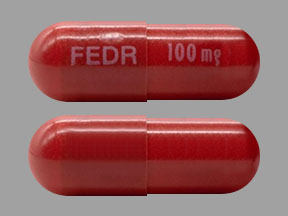Fedratinib Side Effects
Medically reviewed by Drugs.com. Last updated on Aug 19, 2023.
Applies to fedratinib: oral capsule.
Warning
Oral route (Capsule)
Warning: Encephalopathy including Wernicke'sSerious and fatal encephalopathy, including Wernicke’s, has occurred in patients treated with fedratinib. Wernicke’s encephalopathy is a neurologic emergency. Assess thiamine levels in all patients prior to starting fedratinib, periodically during treatment, and as clinically indicated. Do not start fedratinib in patients with thiamine deficiency; replete thiamine prior to treatment initiation. If encephalopathy is suspected, immediately discontinue fedratinib and initiate parenteral thiamine. Monitor until symptoms resolve or improve and thiamine levels normalize.
Serious side effects of Fedratinib
Along with its needed effects, fedratinib may cause some unwanted effects. Although not all of these side effects may occur, if they do occur they may need medical attention.
Check with your doctor immediately if any of the following side effects occur while taking fedratinib:
More common
- Black, tarry stools
- bleeding gums
- blood in the urine or stools
- chills
- cough
- fever
- lower back or side pain
- painful or difficult urination
- pale skin
- pinpoint red spots on the skin
- sore throat
- trouble breathing with exertion
- ulcers, sores, or white spots in the mouth
- unusual bleeding or bruising
- unusual tiredness or weakness
Less common
- Bladder pain
- cloudy urine
- confusion
- difficult, burning, or painful urination
- drowsiness
- frequent urge to urinate
- lower back or side pain
- shakiness and unsteady walk
- trouble remembering
- uncontrolled eye movements
- unsteadiness, trembling, or other problems with muscle control or coordination
Incidence not known
- Anxiety
- chest pain
- dizziness or lightheadedness
- fainting
- fast heartbeat
- general feeling of illness
- pain, redness, or swelling in arm or leg
- pains in the chest, groin, or legs, especially calves of legs
- persistent non-healing sore
- pink growth
- reddish patch or irritated area
- shiny bump
- sudden loss of coordination
- sudden onset of slurred speech
- sudden vision changes
- swollen glands
- weight loss
- white, yellow or waxy scar-like area
- yellow skin and eyes
Other side effects of Fedratinib
Some side effects of fedratinib may occur that usually do not need medical attention. These side effects may go away during treatment as your body adjusts to the medicine. Also, your health care professional may be able to tell you about ways to prevent or reduce some of these side effects.
Check with your health care professional if any of the following side effects continue or are bothersome or if you have any questions about them:
More common
- Bone pain
- diarrhea
- headache
- lack or loss of strength
- muscle spasms
- nausea
- pain in the arms or legs
- vomiting
- weight gain
For Healthcare Professionals
Applies to fedratinib: oral capsule.
General
The most commonly reported side effects included anemia, diarrhea, nausea, and increased blood creatinine.[Ref]
Cardiovascular
Common (1% to 10%): Cardiac failure, cardiogenic shock, hypertension, myocardial ischemia
Frequency not reported: Major adverse cardiac events (MACE), thrombosis[Ref]
Gastrointestinal
Very common (10% or more): Diarrhea (up to 67.5%), nausea (up to 62%), vomiting (up to 44.8%), increased lipase (up to 35%), increased amylase (up to 24%)
Common (1% to 10%): Constipation, dyspepsia
Frequency not reported: Gastrointestinal toxicity[Ref]
Genitourinary
Common (1% to 10%): Dysuria, urinary tract infection[Ref]
Hematologic
Very common (10% or more): Anemia (up to 99%), thrombocytopenia (up to 68.5%), neutropenia (up to 23%)
Common (1% to 10%): Bleeding[Ref]
Hepatic
Very common (10% or more): Elevated ALT (up to 43%), elevated AST (up to 40%)
Frequency not reported: Liver toxicity[Ref]
Metabolic
Very common (10% or more): Hyponatremia (up to 26%)
Common (1% to 10%): Weight gain[Ref]
Musculoskeletal
Very common (10% or more): Muscle spasms (up to 12%), extremity pain (up to 10%)
Common (1% to 10%): Bone pain[Ref]
Nervous system
Common (1% to 10%): Dizziness, headache, Wernicke's encephalopathy
Frequency not reported: Encephalopathy[Ref]
Other
Very common (10% or more): Asthenia/fatigue (up to 19%)[Ref]
Renal
Very common (10% or more): Blood creatinine increased (up to 59%)
Frequency not reported: Cystitis[Ref]
Oncologic
Frequency not reported: Secondary malignancies[Ref]
More about fedratinib
- Check interactions
- Compare alternatives
- Reviews (1)
- Dosage information
- During pregnancy
- Drug class: multikinase inhibitors
- Breastfeeding
- En español
Patient resources
Other brands
Professional resources
Other brands
Related treatment guides
References
1. Product Information. Inrebic (fedratinib). Bristol-Myers Squibb. 2022.
2. Product Information. Inrebic (fedratinib). Bristol-Myers Squibb Pharmaceuticals Ltd. 2021.
Further information
Always consult your healthcare provider to ensure the information displayed on this page applies to your personal circumstances.
Some side effects may not be reported. You may report them to the FDA.

